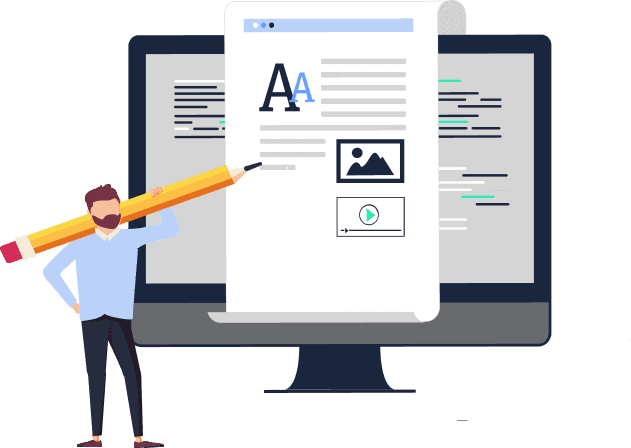
Why technical writers should learn UX writing

Patrick Stafford

Interested in UX writing and content design?
Explore our content design and UX writing training:

Technical writer skills are often focused on one thing: documentation. But this type of segmented mode of product development is outdated. Technical writers need to be embedded directly into the product.
By embracing UX writing skills, technical writers can transform their documentation and write for an entire product experience – not just one small part of it.
This guide explores why acquiring UX writing skills is essential for technical writers and how it can help bridge the gap between complex technical content and user-friendly design, ultimately making the work more impactful and relevant.
Why technical writer skills should include UX writing
At its core, UX is about creating products that are functional, intuitive, and enjoyable to use. It’s the discipline of designing experiences that are seamless, efficient, and user-friendly, ensuring that users can achieve their goals with minimal friction. The aesthetics of an interface are important, but UX is fundamentally about problem-solving and optimizing the way users interact with technology.
Technical writers, who are accustomed to crafting detailed documentation and instructions, are uniquely positioned to influence UX. Their ability to present complex information in a clear and accessible way directly impacts how users experience a product. By integrating UX principles into their work, technical writers can enhance the usability of their content and, by extension, the product itself.
UX’s role in enhancing user satisfaction
User satisfaction is a critical metric for any product’s success. Users who find a product easy to navigate and understand are more likely to continue using it, recommend it to others, and have a positive perception of the brand. For technical writers, this means that the clarity and usability of their content are pivotal. UX principles can guide them in creating documentation that not only informs but also anticipates user needs and facilitates smoother interactions.
Driving product success through UX
Incorporating UX and content design into technical writing isn’t just about making content more user-friendly; it’s about aligning documentation with the overall product experience. This holistic approach can reduce user frustration, lower support costs, and increase user retention. Technical writers who apply UX principles help create a cohesive and engaging user journey, where documentation is seamlessly integrated into the product, enhancing the overall experience and contributing significantly to product success.
One of the better and more recent examples of a company incorporating documentation into the overall product experience is Stripe. A highly technical product, Stripe has been able to maintain strong loyalty among users by making sure its documentation sits within the experience, not just to the side.
Technical writing vs UX writing
At first glance, technical writing and UX writing might seem similar, given that both disciplines involve creating content that helps users interact with technology. But while there are significant overlaps, each field has distinct goals and approaches that set them apart.
Similarities between technical writing and UX writing
Both technical writing and UX writing are user-centered disciplines. They aim to provide clear, concise, and accessible information that helps users accomplish their goals. Technical writers and UX writers share a commitment to understanding their audience, anticipating user needs, and presenting information in an easily digestible format. Whether it’s through comprehensive manuals or concise interface prompts, both roles strive to enhance the user’s understanding and experience with a product.
Another commonality is the focus on clarity and precision. Technical and UX writers must distill complex information into straightforward, user-friendly language. This requires a deep understanding of the subject matter and the ability to communicate it effectively to the user, regardless of their technical proficiency.
Addressing common misconceptions
One common misconception is that technical writing is solely about creating dense, jargon-heavy documents, while UX writing is about making things sound friendly and approachable. In reality, both roles require a nuanced understanding of the user’s needs and the ability to communicate effectively. Technical writers are increasingly adopting UX principles to make their documentation more user-friendly, while UX writers must be meticulous and detail-oriented to ensure clarity and accuracy in their content.
Another misconception is that transitioning between the two disciplines is straightforward because they both involve writing. While there are transferable skills, each role requires a unique mindset and approach. Technical writers looking to move into UX writing need to develop an understanding of interface design and user interaction patterns, while UX writers must be prepared to delve into more detailed, instructional content when stepping into technical writing.
While technical writing and UX writing share a common goal of aiding the user, they approach this goal from different angles and require distinct skill sets. Understanding these differences is crucial for technical writers who wish to expand their capabilities and contribute more effectively to user-centered design.
Key differences between technical and UX writing
While technical writing and UX writing both aim to enhance user understanding and satisfaction, they differ significantly in their focus, style, and objectives. These differences are crucial for technical writers to grasp as they explore the potential benefits of incorporating UX writing skills into their repertoire.
Focus
Technical writing: The primary focus of technical writing is to provide comprehensive and detailed documentation that helps users understand and operate complex products or systems. Technical writers create content like user manuals, installation guides, and technical specifications that explain intricate functionalities and procedures in a step-by-step manner. Their goal is to cover all aspects of a product thoroughly to prevent user confusion and reduce the need for additional support.
UX writing: UX writing, on the other hand, is centered around the user’s journey within a product interface. UX writers focus on crafting microcopy that facilitates seamless interactions and guides users through tasks efficiently. Their work is embedded within the user interface, such as buttons, prompts, tooltips, and error messages, providing just-in-time information that enhances the user experience by being immediate, contextual, and intuitive.
Style
Technical writing: The style of technical writing tends to be formal, precise, and exhaustive. Technical writers often employ structured formats, including numbered steps, bullet points, and detailed explanations to ensure clarity and thoroughness. The language used is specific and jargon-laden, tailored to an audience that requires in-depth understanding of the subject matter. For example, a technical document for software might include detailed descriptions of settings, functions, and troubleshooting steps.
UX writing: In contrast, UX writing is concise, conversational, and user-friendly. It avoids technical jargon and focuses on being clear and approachable, ensuring that users can quickly grasp and act on the information. UX writing often employs a friendly tone and uses active voice to engage users directly. For instance, a button might be labeled “Get Started” instead of “Begin Initial Setup Procedure,” emphasizing simplicity and action.
Objectives
Technical writing: The main objective of technical writing is to provide comprehensive knowledge and ensure that users can fully understand and utilize a product. Technical writers aim to document all possible user scenarios, provide detailed instructions, and offer solutions to potential issues. Their work is designed to be a definitive resource that users can refer to for in-depth information.
UX writing: The objective of UX writing is to enhance the overall user experience by making interactions within the product as smooth and intuitive as possible. UX writers aim to reduce user friction, prevent errors, and make the product experience more enjoyable and efficient. Their content is designed to guide users seamlessly through tasks without overwhelming them with information. For example, a UX writer might create an inline hint that gently corrects a user’s input mistake, helping them to quickly correct the error and continue with their task.
Examples
Technical writing: A technical writer working on a software manual might include a detailed section on configuring advanced settings. This section would explain each setting, its purpose, and step-by-step instructions on how to adjust them, complete with screenshots and troubleshooting tips.
UX writing: A UX writer might work on the same software, but their focus would be on the wording of the settings labels and instructions within the interface. Instead of “Configuration Settings for Advanced Users,” they might label it simply as “Advanced Settings,” with a brief, intuitive description and clear, actionable instructions like “Click here to customize your preferences.”
In summary, while both technical and UX writing aim to support users, they do so in fundamentally different ways. Understanding these differences enables technical writers to effectively incorporate UX writing principles, enhancing both their documentation and the user experience.
How do UX and technical writer skills overlap?
Although UX writing and technical writing serve different primary functions, they share several key principles that lead to significant overlap. Both disciplines are committed to creating content that is user-centric, clear, and accessible, and there are many scenarios where these skills complement each other effectively.
User-centric content
Both UX writers and technical writers place the user at the center of their work. They strive to understand user needs, pain points, and behaviors to create content that addresses these effectively. Technical writing aims to provide comprehensive information that helps users operate products successfully, while UX writing focuses on guiding users through product interfaces in an intuitive manner.
For example, a technical writer might create a detailed user guide for software, outlining every feature and providing step-by-step instructions. Simultaneously, a UX writer would be involved in the design process, crafting in-app guidance and tooltips that help users understand and use features without needing to refer to the guide. Together, these efforts ensure that users have the support they need, whether they are looking for detailed information or immediate, context-sensitive help.
Clarity
Clarity is another fundamental aspect where UX and technical writing overlap. Both disciplines prioritize clear and concise communication, making complex information accessible and understandable to users. Whether it’s a technical document explaining a complex process or a UX microcopy directing users through an interface, the goal is to eliminate ambiguity and facilitate user comprehension.
For instance, in a user manual, a technical writer would use clear language to explain how to set up and use a device. At the same time, a UX writer working on the device’s software interface would ensure that labels, buttons, and error messages are straightforward and easy to understand, enhancing the user’s ability to navigate the device without confusion.
Accessibility
Accessibility is a shared concern for both technical and UX writers. They work to ensure that all users, regardless of their abilities, can access and benefit from the content. This involves writing content that is easily readable, using clear headings, and providing alternative text for images, among other practices.
For example, a technical writer might ensure that a manual is formatted with clear headings, ample white space, and descriptive alt text for images, making it easier for users with visual impairments to understand. Concurrently, a UX writer might ensure that the software interface adheres to accessibility standards, with features such as keyboard navigability, screen reader compatibility, and easily distinguishable colors, ensuring a broader range of users can interact with the product effectively.
Complementary scenarios
In many scenarios, UX and technical writing skills complement each other seamlessly. Consider a scenario where a technical writer is documenting a complex software tool. The documentation provides in-depth explanations and guides, while the UX writer focuses on creating in-app tutorials and help prompts that provide immediate assistance as users navigate the tool. This complementary approach ensures that users have access to both detailed information and real-time guidance, enhancing their overall experience and reducing the learning curve.
By understanding and leveraging these overlaps, technical writers can integrate UX principles into their work, creating content that not only informs but also enhances the user experience. This holistic approach ensures that all users have a positive, productive interaction with the product.
Benefits of UX writing for technical writers
As the digital landscape continues to evolve, technical writers who acquire UX writing skills stand to gain numerous professional and personal advantages. By embracing UX principles, they can expand their skill set, enhance their value within their organizations, and contribute to more user-friendly products.
Professional benefits
1. Enhanced job versatility
Learning UX writing skills equips technical writers with the ability to handle a broader range of tasks, from creating detailed documentation to crafting intuitive interface copy. This versatility makes them more valuable to employers and opens up opportunities for roles that require a combination of technical and UX writing expertise.
2. Increased demand
As more companies recognize the importance of user-centric design, the demand for professionals who can seamlessly blend technical documentation with UX writing continues to grow. Technical writers with UX skills are uniquely positioned to meet this demand, making them attractive candidates for roles in leading tech firms and startups alike.
3. Improved product impact
Technical writers who incorporate UX writing principles into their work can significantly enhance the user experience. By creating content that is not only informative but also engaging and accessible, they help ensure that users can interact with products more easily and effectively. This leads to higher user satisfaction and better product adoption rates, contributing to the overall success of the company.
4. Career advancement
Acquiring UX writing skills can pave the way for career advancement. Technical writers who master these skills are well-placed to move into senior roles, such as content strategists or UX managers, where they can influence the direction of product development and user experience initiatives.
Personal benefits
1. Skill diversification
Learning UX writing provides technical writers with a diverse skill set that is applicable across various domains. This diversification not only makes them more marketable but also enriches their professional capabilities, allowing them to tackle new and exciting challenges.
2. Creative satisfaction
UX writing often involves a creative approach to problem-solving, where writers can experiment with different tones and styles to create the best user experience. This creative aspect can be highly rewarding, offering a refreshing change from the more structured nature of traditional technical writing.
3. Personal fulfillment
Many professionals find personal fulfillment in knowing that their work directly contributes to enhancing the user experience. By making complex products easier to use, technical writers can take pride in the positive impact their content has on users’ lives.
Embracing UX writing skills not only benefits technical writers professionally but also provides personal satisfaction and fulfillment. It’s a transformative step that allows them to contribute more deeply to the user experience and achieve greater success in their careers.
The importance of embedding UX in technical documentation
Embedding UX principles into technical documentation transforms it from a mere informational resource into an integral part of the user experience. By adopting a user-centric approach, technical writers can create documentation that is not only more effective but also enhances the overall usability and satisfaction of the product.
Enhancing effectiveness through UX principles
1. Improved usability:
Traditional technical documentation often focuses on providing exhaustive details without considering how users will interact with the information. By incorporating UX principles, technical writers can design documentation that is intuitive and easy to navigate. This means organizing content logically, using clear headings and subheadings, and providing quick access to the most relevant information. The goal is to help users find what they need with minimal effort, reducing frustration and enhancing their experience.
2. Increased accessibility
UX principles emphasize the importance of accessibility, ensuring that documentation is usable by a diverse range of people, including those with disabilities. This involves using clear and simple language, providing alternative text for images, and ensuring that the content is compatible with screen readers and other assistive technologies. Accessible documentation not only meets legal and ethical standards but also broadens the user base by making it possible for more people to use the product effectively.
3. Contextual relevance:
UX writing focuses on providing information that is directly relevant to the user’s current context. Applying this principle to technical documentation involves embedding help and guidance within the user’s workflow, rather than isolating it in a separate manual. This could mean integrating tooltips, inline help, and contextual links within the product interface that guide users exactly when and where they need assistance. This approach reduces cognitive load and helps users complete tasks more efficiently.
Examples of improved documentation
User manuals:
Consider a traditional user manual for a complex software application. Typically, such manuals are lengthy, densely packed with information, and often difficult to navigate. By applying UX principles, this manual can be restructured into a more user-friendly format. For instance, the manual could include a quick-start guide for new users, contextual hyperlinks for deeper dives into specific topics, and a search function that allows users to find information quickly. Each section can be designed to be more concise, focusing on essential tasks and troubleshooting tips.
Online help systems:
Traditional help systems are often static and separate from the actual product, requiring users to leave their workflow to seek assistance. By embedding UX principles, these systems can be transformed into dynamic, integrated resources that provide real-time assistance. For example, an online help system could feature interactive tutorials, in-app notifications for common user errors, and a searchable FAQ section that is easily accessible from within the product. This approach not only improves usability but also supports continuous learning and reduces the need for external support.
Incorporating UX principles into technical documentation fundamentally shifts the focus from simply delivering information to creating a seamless and supportive user experience. By making documentation more intuitive, accessible, and contextually relevant, technical writers can significantly enhance the effectiveness of their content and contribute to a more positive overall user experience.
How to transition from technical to UX writing
Transitioning from technical writing to UX writing involves expanding your skill set to include a user-centric approach to content creation that focuses on enhancing the overall user experience. Here’s a roadmap to guide you through the transition, along with suggested courses, resources, and key skills to focus on.
Roadmap for transition
1. Understand the basics of UX design:
Begin by familiarizing yourself with the fundamental concepts of UX design. Understanding the principles of user-centered design, usability, and user research will provide a strong foundation for your transition. Books like “Don’t Make Me Think” by Steve Krug and “The Design of Everyday Things” by Don Norman are excellent starting points.
2. Learn the language of UX
Get comfortable with UX terminology and concepts. This includes understanding terms like wireframes, user journeys, personas, and usability testing. Online glossaries and UX-focused websites such as Nielsen Norman Group and UX Design Institute offer great resources for learning the lingo.
3. Take UX writing courses
Enroll in courses specifically designed for UX writing to gain a deeper understanding of the field.
4. Build a portfolio
Start creating a portfolio that showcases your ability to write for user interfaces. Include examples of microcopy, user guides, and contextual help that demonstrate your understanding of UX principles. You can use projects from your current role or create sample projects based on hypothetical scenarios.
5. Practice user research
Gain hands-on experience with user research methods such as usability testing, surveys, and interviews. Understanding how to gather and analyze user feedback will help you create more effective and user-centered content. Websites like UserTesting and tools like Google Forms are useful for conducting your own research.
6. Collaborate with UX teams
Seek opportunities to work closely with UX designers, researchers, and product managers. This collaboration will help you understand how UX writing fits into the broader design process and give you insight into how your content can enhance the user experience.
7. Start small and iterate:
Begin by applying UX writing principles to small projects, such as rewriting error messages or creating tooltips. Use these opportunities to test your content with users and gather feedback. Iterating based on user feedback is key to refining your UX writing skills.
8. Stay updated on trends
UX is a rapidly evolving field. Stay informed about the latest trends, tools, and best practices by following UX blogs, attending webinars, and participating in UX communities. Websites like Smashing Magazine, UX Design, and Medium’s UX Collective are great resources for staying current.
Tehcnical writer skills should include content design
As product teams prioritize seamless, user-centered experiences, documentation must move from the sidelines into the heart of the product itself. That shift presents an enormous opportunity for technical writers.
By learning UX writing skills, technical writers can expand their influence, modernize their practice, and contribute more deeply to product design. Whether it’s writing microcopy, shaping user flows, or embedding help content directly into interfaces, technical writers who embrace UX principles will be better positioned to lead, collaborate, and grow.
For technical writers looking to future-proof their careers, UX writing isn’t a detour. It’s the next step.
Frequently asked questions about technical writing and UX writing
What’s the difference between technical writing and UX writing?
Technical writing focuses on explaining complex systems or procedures. Think manuals, help docs, and API documentation. UX writing is about guiding users through a product experience, usually within the interface itself. While technical writers aim to explain, UX writers aim to assist in the moment of action.
Can a technical writer become a UX writer?
Absolutely. Many UX writers start as technical writers. The skills are highly transferable: clarity, structure, empathy, and the ability to translate complexity into simplicity. To transition, technical writers often learn more about user experience principles, product design processes, and writing microcopy.
Do I need a design background to get into UX writing?
No, but understanding design helps. UX writers collaborate closely with designers, product managers, and developers. You don’t need to design interfaces, but you should be comfortable working in design tools like Figma and contributing to user flows, wireframes, or content-first prototypes.
What skills overlap between technical writing and UX writing?
Both roles require:
- Clear, concise writing
- Information architecture and content structuring
- Empathy for the user
- Collaboration with cross-functional teams
- A strong grasp of product and technology
The key difference is where and when that content shows up in the user journey.
Will learning UX writing help me advance my career as a technical writer?
Yes. As digital products evolve, teams increasingly expect content professionals to shape the full user experience—not just the documentation. Learning UX writing helps technical writers expand their impact, stay relevant, and move into more strategic roles.
How can I start learning UX writing?
Start by:
- Studying examples of UX writing in products you use.
- Taking online courses (like those at UX Content Collective).
- Practicing writing interface text, error messages, and onboarding flows.
- Learning design basics and using tools like Figma



